
|

|
|
Home Site Search Contact Us Subscribe
|
|
Building Abundance #5: Small City Rejuvenation and Architectural Abundance Schools are more than conduits of knowledge - education is critical to both social and economic stability. Through regenerative design, architects can rethink of how learning is delivered that emphasizes its importance to small cities and rural areas. By Edward McGraw, AIA, LEED AP BD+C October 23, 2019 Editor’s note: This is the fifth in a series on abundance created and curated by Edward McGraw, AIA, LEED AP BD+C, founding partner and chief executive officer of Ashley McGraw Architects. See previous columns by McGraw, Plaut, Fedrizzi, and Angarano at the end of this column.
For much of the past decade, the populations of American cities and metropolitan areas have been steadily growing while those of small towns have been contracting. Somewhat surprisingly, that trend is now showing signs of reversing. According to an analysis of census estimates by Stateline, an initiative of The Pew Charitable Trusts, rural areas, which are defined by the U.S. Department of Agriculture as counties outside cities and their suburbs, gained population between 2016 and 2017 for the first time since 2010. Nationwide, 1,976 counties grew by about 33,000 residents, after losing more than 15,000 residents the year before.
This shift has potentially profound implications. Particularly in small cities and rural areas, schools are more than conduits of knowledge; they are institutions that tie the community together over the course of generations. To keep their students competitive, schools need to be current with their curriculum, pedagogical program, and physical facilities. In a world of accelerating change, education is critical to both social and economic stability. We need a rethink of how learning is delivered that emphasizes its importance to smaller towns and cities.
Through regenerative design, architects can play a key part in maintaining this momentum, and ultimately in sustaining these villages, parishes, and hamlets. Design solutions must be very specific to the place. Small towns, with their limited dynamics, don’t lend themselves well to models based on big-city context. To respond constructively to their unique issues, we must take a more holistic approach that addresses economic, social, and environmental priorities, as well as architectural factors.
One example of regenerative design in action is in a post-industrial New York community. Eight years ago, Hurricane Irene and Tropical Storm Lee caused the Susquehanna River to flood parts of the small city of Binghamton, New York. A local school, MacArthur Elementary, was inundated with contaminated water. The school – which had long been the heart of a vibrant community and served an ethnically, socio-economically, and racially diverse population with a host of after-school programs and adult/community education – was declared a total loss.
With the help of federal and state funding, local stakeholders (including the school board, administration, neighbors, students, parents, and staff) had the opportunity to create a vision for a new school that was suited for the 21st century. The team at Ashley McGraw worked with them to redefine not only what the school itself could be, but how it would work to help heal the neighborhood.
An important part of the process was meeting with school staff and students to learn about their needs and dreams for the new school. One of the key takeaways was a desire for “third spaces”: open, flexible areas throughout the school and its grounds where people – from the community as well as the school – can bond and socialize. Some of these spaces honor the original MacArthur school, and enable an emotional continuity with it.
For instance, the one-time walking track has been re-imagined as a nature path, which students share with town residents. Winding through new plantings of indigenous vegetation, bioswales, and rain gardens, it is now a place where students and the public can learn, engage, and enjoy nature together. Similarly, the new building was deliberately sited to strengthen the connection to the adjacent MacArthur Park, blurring the boundaries between the community and the school and encouraging interaction. These shared spaces proved to have particular resonance when the school reopened, and the student body – which had been dispersed among two remote schools for four years while the new MacArthur was constructed – was reunited.
The building itself is also future-oriented, featuring energy-conscious systems for climate control, ventilation, and lighting, sustainable materials, and resilient site design. Set on columns, the classroom wings are elevated 12 feet above grade to allow the river to flood and recede naturally over time. The school was recently certified LEED Platinum, one of the first for a K-12 school in New York State.
MacArthur Elementary is a modest but successful example of how to make a place that enables people to thrive, and to make an abundant existence for themselves, now and for generations to come.
Ed McGraw, AIA, LEED AP BD+C, is founding partner and chief executive officer of Syracuse-based Ashley McGraw Architects. He is a nationally recognized authority on sustainability and high-performance buildings, and speaks frequently on the subject. Among the organizations he has addressed are the American Institute of Architects National Convention, Northeast Sustainable Energy Association, New York State Green Building Conference, Council of School Superintendents and School Boards Association, and the Eastern Region of the Association of Physical Plant Administrators. He holds a Master of Architecture degree from Syracuse University and a bachelor’s degree in business from SUNY Binghamton.
See also:
Building Abundance
#4: Abundance from Regeneration - Our Opportunity as Designers
Building Abundance #3: Abundance in Architecture Starts with Abundance in Human Health Just as buildings became an incredible tool in the movement for environmental sustainability, they can and must become our greatest asset when it comes to human sustainability. By Rick Fedrizzi
Building Abundance #2: Three Keys to Abundant Design Hint:
Designing for less bad won't get us there. Aiming for abundant design requires
seeing and working in new ways that are largely unfamiliar, challenging - but
oh so worth it!
Creating abundance is more than sustainability or resilience, and should be a driving force in architecture. By Edward McGraw, AIA, LEED AP BD+C |
(click on pictures to enlarge) 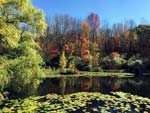 Ashley McGraw Architects Google defines abundance as “plentifulness of the good things in life.” 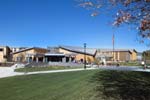 John Griebsch Photography After the existing MacArthur Elementary School in Binghamton, NY, was destroyed by flooding in 2011, Ashley McGraw Architects designed a new school, the first LEED Platinum K-12 school in New York State. 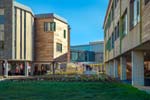 John Griebsch Photography Three 2 -story classroom wings are raised on columns to allow the river to flood and recede naturally over time. 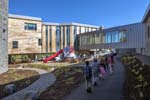 John Griebsch Photography Rain gardens, bio-swales, and indigenous vegetation are used to treat water on site, and demonstrate and teach about the hydrological cycle of the site. 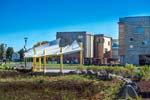 John Griebsch Photography An outdoor amphitheater allows students and teachers to interact outside the traditional classroom.  John Griebsch Photography The amphitheater with the three raised classroom wings.  John Griebsch Photography A playscape underneath the raised academic wings. 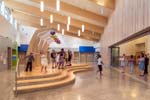 John Griebsch Photography Interior spaces was Informal collaborative areas and in-between spaces (third spaces) were influenced by student input that “learning takes place everywhere and all the time.” 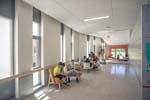 John Griebsch Photography In-between spaces accommodate ever-evolving pedagogy |
© 2019 ArchNewsNow.com